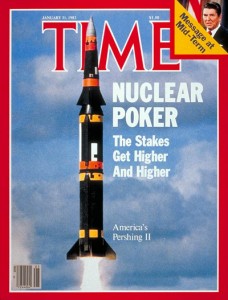
In a 2005 interview, former Western Group of Forces commander, Colonel General Matvei Burlakov, explained that, in his view, the peak of the Cold War was in the 1980s. Soviet plans were to strike pre-emptively, he asserted, when tensions first started to rise in a crisis. All that remained was for the signal to be sent and they would be the first to do so. He also stated that they would be the first to employ nuclear weapons in such a scenario: “Gromyko may have said one thing, but the military had other ideas.”
The debate over the Cold War end game and its components is now well underway. Recently there has been substantial public attention directed at a possible nuclear crisis that emerged around the mounting of NATO command post exercise, ABLE ARCHER 83 that was held in November 1983 coincident with the deployment of the Pershing II (P II) missile system to West Germany. One view suggests that the ABLE ARCHER event, however we define it, was akin to or on par with the Cuban Missile Crisis. Another view downplays its gravity and places the event within the context of the influence campaign waged between the Soviets and NATO over the Theatre Nuclear Force (later Intermediate Nuclear Force) modernization issue that dominated public debate starting years earlier in 1977. Consequently, we have a lack of consensus even on identifying the species of situation we are looking at.
This article proposes a new and broader framework to contextualize ABLE ARCHER. Indeed, it was not the events of November 1983 that were necessarily an issue on the nuclear front. It was what happened afterwards over the course of the next two years that was potentially problematic for US-Soviet relations. The number of incidents and accidents incurred by Soviet nuclear forces were a possibly greater threat than the events surrounding ABLE ARCHER 83. And, up to now, there is no comprehensive examination of such incidents comparable to the vast amount of information available on their American equivalents.
This article appeared in a shortened form in Survival. Here is the FULL VERSION.